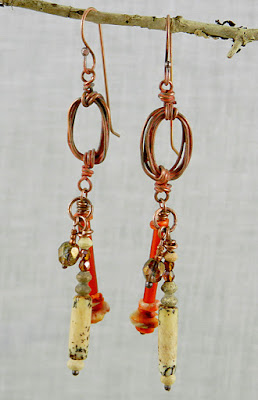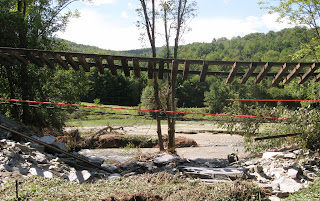So to end up 2011 I decided to give them all homes in earring sets. Or at least 12 sets-- it resonates somehow with 'The Twelve Days of Christmas'-- “12 pairs of earrings, 11 lords a'leaping, 10 ladies dancing”, etc. These are going immediately into my Etsy shop or they'll end up being worn by me!
For all of you who are doing some late shopping or just because we all need to gift ourselves sometimes-- for whatever reason-- here are my offerings and please enjoy the eye candy. They're the only sweets this holiday season that won't go right to your hips!
I'm rushing to get these listed in my Etsy shop but if you fancy a particular pair, please convo me at Etsy and I can put a Reserve listing up for you.
And from our house to yours--have yourselves a Merry Little Christmas!
Imaginarium earrings - Available in my Etsy shop
Textured and stacked polymer clay dangles, patinated with acrylic
paint and gilders wax, embellished with frosted resin windows
Poinciana earrings - Available in my Etsy shop
Polymer clay patterned with handmade molds, colored with oil paints and gilders wax - brass earwires
Winter Moon earrings - Available in my Etsy shop
Polymer clay patterned with a mold made from an antique picture frame, colored with alcohol inks, embellished with handforged copper washers patinated with gilders wax - copper earwires
Ulan Bator earrings - Available in my Etsy shop
African glass, coral disks, Ethiopian clay spacers, copper spacers and findings, handmade and patinated links, crystals, tagua nut tubes
Ostia earrings - Available in my Etsy shop
Handmade polymer clay stacked elements with resin centers, patinated with gilders wax, antique Roman glass disks, Greek ceramic spacers, brass spacers and findings
Horn of Africa earrings - Available in my Etsy shop
Handmade and textured polymer clay dangles, antiqued brass beads,
handmade enamel bead caps by Mairedodd, brass earwires
Telluride earrings - Available in my Etsy shop
Polymer clay formed with a mold made from an antique picture frame and colored with alcohol inks and colored pencil - copper earwires
Edgy Sugarplum earrings - Available in my Etsy shop
Polymer clay textured with a mold from an antique picture frame,
colored with alcohol inks and patinated with gilders wax - silver earwires
Silken Tent earrings - Available in my Etsy shop
Polymer clay disks, rayon fibers, African bronze spacers, bone beads, Ghana daisy spacers, handforged bronze earwires
Heart of Winter earrings - Available in my Etsy shop
Polymer clay hearts from a repousse original, handforged and patinated antique bronze disks, antique star findings, bone spacers, bronze earwires
Carpathia earrings - Available in my Etsy shop
Polymer clay mokume gane technique dangles, repourposed patinated brass embellishments, bronze earwires
Valley of the Kings earrings - Available in my Etsy shop
Polymer clay elements done in the mokume gane technique, handforged and patinated brass washers and dangles, bronze spacers and earwires

























































